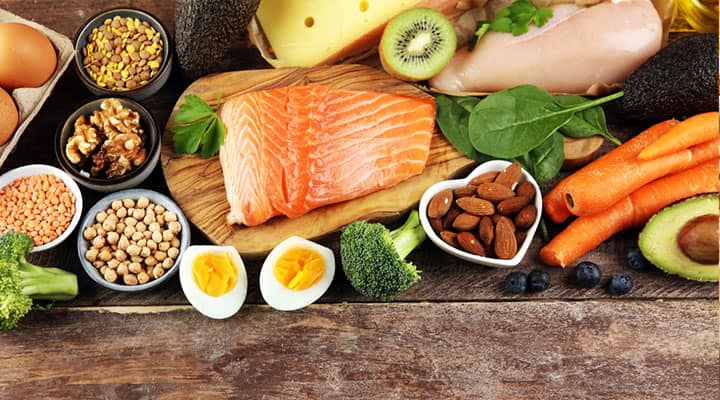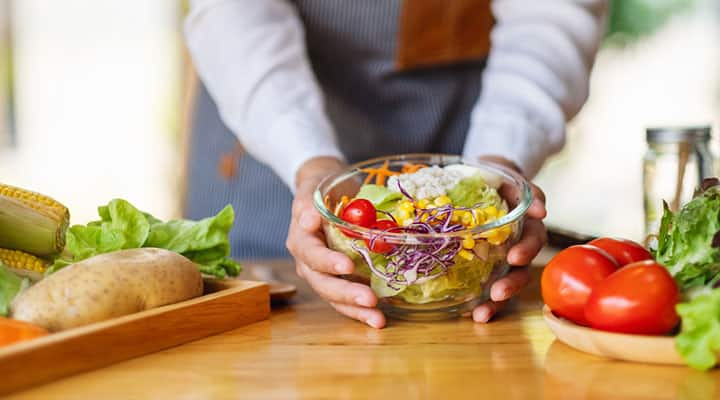
How to Manage Inflammation by Eating the Right Foods
Published: April 2021
Chronic inflammation is the "common denominator" of many age-related diseases—it's associated with heart disease, many cancers, and Alzheimer's disease. But the foods you eat can provide a potent defense against it.
Now, you're probably familiar with inflammation on the surface of your body as local redness, heat, swelling and pain. But inflammation also happens on the inside of your body, and this is where it can be the most dangerous to your health.
Inflammation is characterized by increased blood flow to an area of infection or injury. In this process, your blood carries white blood cells, nourishment and repair cells to the injury site to aid in recovery. This is essential for helping you overcome infections and injuries. However, when inflammation persists, it becomes chronic and can actually damage your body and cause illnesses.
So what causes chronic inflammation? Stress, lack of exercise, genetic predisposition, and exposure to toxins are all common culprits. However, there's another major cause that's often overlooked: your diet.
The foods we eat can cause inflammation or they can reduce inflammation. Below, we'll examine this in detail.
What foods cause inflammation?

The typical American diet is rich in animal protein, which is a source of arachidonic acid — a polyunsaturated omega-6 fatty acid that may increase inflammation. Arachidonic acid generates a number of potent inflammatory compounds, including the following:
- Prostaglandins, lipid compounds that have hormone-like effects in the body
- Prostacyclins, which dilate the blood vessels of your cardiovascular system and make it harder for platelets to clump together
- Leukotrienes, which produce excess mucus and fluid
- Thromboxanes, which encourage blood clotting and constriction of blood vessels
These compounds are all essential for your health, however excess levels can contribute to the damage of chronic inflammation. Below is a short list of foods high in omega-6 fatty acids that anyone with an inflammatory condition may want to consider limiting—or even avoiding entirely:
- Red meat – especially fatty red meat
- White meat – chicken, duck & wild fowl
- Dairy – any animal milk
- Eggs – especially the yolk
- Cheeses – especially hard cheeses
- Certain fish – tilapia, catfish, yellowtail
You might be surprised to see some foods that most of us consider healthy on this list. That's because experts generally recommend a balance of omega-3 and omega-6 fatty acids. Omega-3 fatty acids help reduce inflammation, while some omega-6 fatty acids tend to promote inflammation. The key is balance.
Unfortunately, the typical American diet tends to contain far more omega-6 fatty acids than omega-3 fatty acids. Fixing this balance by limiting the omega-6 foods and striving instead for more omega-3-rich foods can go a long way toward easing inflammation.
What foods reduce inflammation?

So what foods contain omega-3 fatty acids to counterbalance the omega-6 fatty acids we consume? Fortunately, nature offers us plenty of delicious foods that are anti-inflammatory—and include nutrients aside from omega-3s, too.
The table below includes some anti-inflammatory foods that are known to reduce inflammation, while also supplying us with essential vitamins and minerals that can boost our overall health:
Type of food / nutrient |
Best sources |
Supporting research |
Omega-3 fatty acids |
Oily fish like salmon, tuna, sardines, anchovies |
Omega-3s suppress multiple steps in the inflammatory process and limit the production of inflammatory cytokines. |
Monounsaturated fat and oils |
Olive oil, canola, walnut, grape seed oil |
Olive oil decreases activation of inflammatory cellular pathways. |
Seeds & nuts |
Flax seeds, pumpkin, walnuts |
Frequent nut consumption is associated with a healthy inflammatory biomarker profile, and flaxseeds are linked to lower levels of some inflammatory markers. |
Whole grains |
Quinoa, bulgur wheat, barley, oats, rye |
Whole grains may offer anti-inflammatory benefits through several mechanisms, including modulating the gut microbiome. |
Dark fruits |
Tart cherries and dark berries |
Tart cherry anthocyanins provide protection against pain and inflammation. Anthocyanins also help reduce C-reactive protein (CRP, a marker of inflammation). |
Green & black tea |
Tea containing Camellia sinensis |
Catechins and theaflavins from tea may help reduce inflammation, including neuroinflammation, by suppressing inflammatory signaling pathways. |
Seaweed |
Brown kelp, wakame, arame |
Seaweed is rich in fucoidan, a natural compound that has anti-inflammatory properties. It's also one of the key nutrients thought to contribute to the exceptionally long lives of people living in Okinawa. |
Is your diet anti-inflammatory?

Want to measure how much of your diet contains foods that cause inflammation—and how much is anti-inflammatory? Try this: Keep a food diary for one week. Create a table with five columns — meats, dairy, fruits, vegetables and grains. Place a checkmark in the appropriate column every time you eat a serving of food from that category. At the end of the week, simply tally your checkmarks to see where you land.
Here’s an example diary:

If you have more checkmarks to the left of the table, you’re eating what we’d consider to be a pro-inflammatory diet. If you have more checkmarks to the right, you’re eating an anti-inflammatory diet.
Please note: This table is not an exact science. It's just a simple means of helping you assess your own diet!
So how does your diet measure up? Remember, you are what you eat. Consider foods that fight inflammation – instead of feeding it – when deciding what's for dinner.
References
- Int J Environ Res Public Health. 2020;17(11)
- J Neuroinflammation. 2020;17(1):30.
- Nutr Hosp. 2011;26(2):323-9.
- Nutrients. 2020;12(9)
- Endocr Metab Immune Disord Drug Targets. 2018;18(1):23-35.
- Cells. 2020;9(2)
- Am J Clin Nutr. 2016;104(3):722-8.
- Adv Nutr. 2019;10(6):1108-1119.
- Nutr Rev. 2020;78(Supplement_1):21-28.
- Mol Nutr Food Res. 2020:e2000473.
- J Cell Physiol. 2019;234(3):2447-2459.
- Nutrients. 2019;11(6)
- Mar Drugs. 2020;18(6)
- Asia Pac J Clin Nutr. 2001;10(2):159-64.
Like what you read?
Please subscribe to get email updates on this blog.



